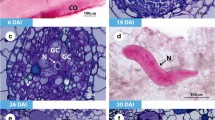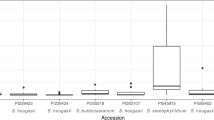Abstract
The root knot nematode (RKN) Meloidogyne luci, recently added to the European Plant Protection Organization Alert List, represents a potential threat to the production of important solanaceous crops. RKN resistance in tomato (Solanum lycopersicum L.) is conferred by a single dominant gene. The objectives were to screen the RKN resistance Mi-1.2 gene in 27 tomato hybrids and cultivars and assess the ability of M. luci and M. ethiopica to reproduce on these accessions. Thirteen Mimi tomato genotypes, two MiMi and twelve lacking the Mi-1.2 gene (mimi) were identified. Tomato accessions Reconquista (MiMi) and Vimeiro F1, Paipai, Sahel, Agora F1, Amaral, Valoasis RZ F1 and SV1917 (Mimi) displayed a resistant reaction to both RKN species with a reproduction factor (Rf) ranging from 0.00 to 0.14. Significant differences in M. luci and M. ethiopica reproduction were detected among and within the Mi-1.2 allelic conditions, which may reflect a dosage effect of the gene as well as an influence of the plant’s genetic background, respectively. Results revealed that resistant tomato accessions carrying the resistant Mi gene have potential to be employed as an alternative to the use of nematicides aiming to control M. luci, and M. ethiopica and the most common RKN species.

Similar content being viewed by others
References
Aydinli, G., & Mennan, S. (2016). Reproductive ability of Meloidogyne ethiopica populations on tomato plant with Mi resistance gene. Abstract book of 32nd ESN (European Societety of Nematologists) Symposium. 28th Aug. - 1st Sept. 2016, Braga, Portugal, Universidade do Minho, European Society of Nematologists, 2016, p. 159.
Aydınlı, G., Mennan, S., Devran, Z., Širca, S., & Urek, G. (2013). First report of the root-knot nematode Meloidogyne ethiopica on tomato and cucumber in Turkey. Plant Disease, 97(9), 1262.
Barbary, A., Djian-Caporalino, C., Palloix, A., & Castagnone-Sereno, P. (2015). Host genetic resistance to root-knot nematodes, Meloidogyne spp., in Solanaceae: From genes to the field. Pest Management Science, 71(12), 1591–1598. https://doi.org/10.1002/ps.4091.
Carneiro, R. M. D. G., Randig, O., Almeida, M. R. A., & Gomes, A. C. M. M. (2004). Additional information on Meloidogyne ethiopica whitehead, 1968 (Tylenchida: Meloidogynidae), a root-knot nematode parasitising kiwi fruit and grape-vine from Brazil and Chile. Nematology, 6(1), 109–123. https://doi.org/10.1163/156854104323072982.
Carneiro, R. M. D. G., Correa, V. R., Almeida, M. R. A., Gomes, A. C. M. M., Deimi, A. M., Castagnone-Sereno, P., & Karssen, G. (2014). Meloidogyne luci n. sp. (Nematoda: Meloidogynidae), a root-knot nematode parasitising different crops in Brazil, Chile and Iran. Nematology, 16(3), 289–301. https://doi.org/10.1163/15685411-00002765.
Castagnone-Sereno, P. (2012). Meloidogyne enterolobii (= M. mayaguensis): Profile of an emerging, highly pathogenic, root-knot nematode species. Nematology, 14(2), 133–138. https://doi.org/10.1163/156854111X601650.
Conceição, I. L., Tzortzakakis, E. A., Gomes, P., Abrantes, I., & da Cunha, M. J. (2012). Detection of the root-knot nematode Meloidogyne ethiopica in Greece. European Journal of Plant Pathology, 134(3), 451–457. https://doi.org/10.1007/s10658-012-0027-0.
Devran, Z., Başköylü, B., Taner, A., & Doǧan, F. (2013). Comparison of PCR-based molecular markers for identification of Mi gene. Acta Agriculturae Scandinavica Section B: Soil and Plant Science, 63(5), 395–402. https://doi.org/10.1080/09064710.2013.771700.
Djian-Caporalino, C., Palloix, A., Fazari, A., Marteu, N., Barbary, A., Abad, P., Sage-Palloix, A. M., Mateille, T., Risso, S., Lanza, R., Taussig, C., & Castagnone-Sereno, P. (2014). Pyramiding, alternating or mixing: Comparative performances of deployment strategies of nematode resistance genes to promote plant resistance efficiency and durability. BMC Plant Biology, 14, 1–13. https://doi.org/10.1186/1471-2229-14-53.
Edwards, K., Johnstone, C., & Thompson, C. (1991). A simple and rapid method for the preparation of plant genomic DNA for PCR analysis. Nucleic Acids Research, 19(6), 1349. https://doi.org/10.1093/nar/19.6.1349.
Gerič Stare, B. G., Strajnar, P., Susič, N., Urek, G., & Širca, S. (2017). Reported populations of Meloidogyne ethiopica in Europe identified as Meloidogyne luci. Plant Disease, 101(9), 1627–1632.
Gerič Stare, B., Strajnar, P., Širca, S., Susič, N., & Urek, G. (2018). Record of a new location for tropical root knot nematode Meloidogyne luci in Slovenia. EPPO Bulletin, 48(1), 135–137.
Gerič Stare, B. G., Aydinli, G., Devran, Z., Mennan, S., Strajnar, P., Urek, G., & Širca, S. (2019). Recognition of species belonging to Meloidogyne ethiopica group and development of a diagnostic method for its detection. European Journal of Plant Pathology, 154(3), 621–633. https://doi.org/10.1007/s10658-019-01686-2.
Hothorn, T., Bretz, F., Westfall, P., Heiberger, R. M., Schuetzenmeister, A., Scheibe, S. (2017). Simultaneous inference in general parametric models. R package ‘multcomp’, Version 1.4–8. http://multcomp.R-forge.R-project.org. Accessed 14 December 2018.
Hussey, R. S., & Barker, K. R. (1973). A comparison of methods of collecting inocula of Meloidogyne spp., including a new technique. Plant Disease Report, 57, 1025–1028.
Jacquet, M., Bongiovanni, M., Martinez, M., Verschave, P., Wajnberg, E., & Castagnone-Sereno, P. (2005). Variation in resistance to the root-knot nematode Meloidogyne incognita in tomato genotypes bearing the Mi gene. Plant Pathology, 54(2), 93–99. https://doi.org/10.1111/j.1365-3059.2005.01143.x.
Janssen, T., Karssen, G., Verhaeven, M., Coyne, D., & Bert, W. (2016). Mitochondrial coding genome analysis of tropical root-knot nematodes (Meloidogyne) supports haplotype based diagnostics and reveals evidence of recent reticulate evolution. Scientific Reports, 6, 1–13. https://doi.org/10.1038/srep22591.
Jones, J. T., Haegeman, A., Danchin, E. G. J., Gaur, H. S., Helder, J., Jones, M. G. K., Kikuchi, T., Manzanilla-López, R., Palomares-Rius, J. E., Wesemael, W. M., & Perry, R. N. (2013). Top 10 plant-parasitic nematodes in molecular plant pathology. Molecular Plant Pathology, 14(9), 946–961. https://doi.org/10.1111/mpp.12057.
Maleita, C. M., dos Santos, M. C. V., Curtis, R. H. C., Powers, S. J., & Abrantes, I. M. de O. (2011). Effect of the Mi gene on reproduction of Meloidogyne hispanica on tomato genotypes. Nematology, 13(8), 939–949. https://doi.org/10.1163/138855411X566449.
Maleita, C. M., Simões, M. J., Egas, C., Curtis, R. H. C., & Abrantes, I. M. de O. (2012). Biometrical, biochemical, and molecular diagnosis of Portuguese Meloidogyne hispanica isolates. Plant Disease, 96(6), 865–874. https://doi.org/10.1094/PDIS-09-11-0769-RE.
Maleita, C., Esteves, I., Cardoso, J. M. S., Cunha, M. J., Carneiro, R. M. D. G., & Abrantes, I. (2018). Meloidogyne luci, a new root-knot nematode parasitizing potato in Portugal. Plant Pathology, 67(2), 366–376. https://doi.org/10.1111/ppa.12755.
Milligan, S. B., Bodeau, J., Yaghoobi, J., Kaloshian, I., Zabel, P., & Williamson, V. M. (1998). The root knot nematode resistance gene Mi from tomato is a member of the leucine zipper, nucleotide binding, leucine-rich repeat family of plant genes. The Plant Cell Online, 10(8), 1307–1320. https://doi.org/10.1105/tpc.10.8.1307.
Nombela, G., Williamson, V. M., & Muñiz, M. (2003). The root-knot nematode resistance gene Mi-1.2 of tomato is responsible for resistance against the whitefly Bemisia tabaci. Molecular Plant-Microbe Interactions, 16(7), 645–649.
Pais, C. S., & Abrantes, I. M. de O. (1989). Esterase and malate dehydrogenase phenotypes in Portuguese populations of Meloidogyne species. Journal of Nematology, 21(3), 342–346.
Pinheiro, J., Bates, D., DebRoy, S., Sarkar. D. & and R Core Team (2018). R-core linear and nonlinear mixed effects models. R Packag “nlme”, Version 3.1–137. https://cran.r-project.org/web/packages/nlme/nlme.pdf. Accessed 14 December 2018.
Roberts, P. A. (1992). Current status of the availability, development, and use of host plant resistance to nematodes. Journal of Nematology, 24(2), 213–227.
Rossi, M., Goggin, F. L., Milligan, S. B., Kaloshian, I., Ullman, D. E., & Williamson, V. M. (1998). The nematode resistance gene Mi of tomato confers resistance against the potato aphid. Proceedings of the National Academy of Sciences of the USA, 95(17), 9750–9754. https://doi.org/10.1073/pnas.95.17.9750.
Santos, D., Correia, A., Abrantes, I., Maleita, C. (2019). New hosts and records in Portugal for the root-knot nematode Meloidogyne luci. Journal of Nematology, 51, https://doi.org/10.21307/jofnem-2019-003.
Sasser, J. N., Carter, C. C., & Hartman, K. M. (1984). Standardization of host suitability studies and reporting of resistance to root-knot nematodes. Raleigh: North Carolina State University Graphics.
Seah, S., Williamson, V. M., Garcia, B. E., Mejía, L., Salus, M. S., Martin, C. T., & Maxwell, D. P. (2007). Evaluation of a co-dominant SCAR marker for detection of the Mi-1 locus for resistance to root-knot nematode in tomato germplasm. Report of the Tomato Genetics Cooperative, 57, 37–40.
Širca, S., Urek, G., & Karssen, G. (2004). First report of the root-knot nematode Meloidogyne ethiopica on tomato in Slovenia. Plant Disease, 88(6), 680.
Sorribas, F. J., Ornat, C., Verdejo-Lucas, S., Galeano, M., & Valero, J. (2005). Effectiveness and profitability of the Mi-resistant tomatoes to control root-knot nematodes. European Journal of Plant Pathology, 111(1), 29–38. https://doi.org/10.1007/s10658-004-1982-x.
Strajnar, P., & Širca, S. (2011). The effect of some insecticides, natural compounds and tomato cv. Venezia with Mi gene on the nematode Meloidogyne ethiopica (Nematoda) reproduction. Acta Agriculturae Slovenica, 97(1), 5–10. https://doi.org/10.2478/v10014-011-0001-0.
Talavera, M., Verdejo-Lucas, S., Ornat, C., Torres, J., Vela, M. D., Macias, F. J., & Sorribas, F. J. (2009). Crop rotations with Mi gene resistant and susceptible tomato cultivars for management of root-knot nematodes in plastic houses. Crop Protection, 28(8), 662–667. https://doi.org/10.1016/j.cropro.2009.03.015.
Taylor, A. L., & Sasser, J. N. (1978). Biology, identification and control of root-knot nematodes (Meloidogyne species). Raleigh: North Carolina State University Graphics.
Williamson, V. M. (1998). Root-knot nematode resistance genes in tomato and their potential for future use. Annual Review of Phytopathology, 36, 277–293.
Williamson, V. M., & Hussey, R. S. (1996). Nematode pathogenesis and resistance in plants. The Plant Cell, 8(10), 1735–1745. https://doi.org/10.1105/tpc.8.10.1735.
Acknowledgments
The authors thank Dr. Regina Carneiro (EMBRAPA – Recursos Genéticos e Biotecnologia, Brasilia, Brazil) for providing M. ethiopica isolate; and Professor José Paulo Sousa (CFE - Centre for Functional Ecology-Science for People & the Planet, Department of Life Sciences, University of Coimbra) for fruitful suggestion with statistical analysis. This research was supported by CFE, Instituto do Ambiente, Tecnologia e Vida, Chemical Process Engineering and Forest Products Research Centre, Department of Chemical Engineering, UC, and FEDER funds through the Portugal 2020 (PT 2020) Programa Operacional Factores de Competitividade 2020 (COMPETE 2020) and by Fundação para a Ciência e a Tecnologia (FCT, Portugal), under contracts UID/BIA/04004/2019, PEst-UID/EQU/00102/2019, POCI-01-0145-FEDER-031946 (Ref. PTDC/ASP-PLA/31946/2017), POCI-01-0145-FEDER-029392 (Ref. PTDC/ASP-PLA/29392/2017) and Project ReNATURE – Valorization of the Natural Endogenous Resources of the Centro Region (Centro2020, Centro-01-0145-FEDER-000007).
Author information
Authors and Affiliations
Corresponding author
Ethics declarations
Conflict of interest
The authors certify that do not have any actual or potential conflict of interest, the study described is original, has not been published previously, and is not under consideration for publication elsewhere. All authors have reviewed the manuscript and approved the final version of manuscript before submission.
Human participants and/or animals
No specific permits were required for the described studies.
Informed consent
The authors certify that the work carried out in this research followed the principles of ethical and professional conduct.
Rights and permissions
About this article
Cite this article
Santos, D., Martins da Silva, P., Abrantes, I. et al. Tomato Mi-1.2 gene confers resistance to Meloidogyne luci and M. ethiopica. Eur J Plant Pathol 156, 571–580 (2020). https://doi.org/10.1007/s10658-019-01907-8
Accepted:
Published:
Issue Date:
DOI: https://doi.org/10.1007/s10658-019-01907-8




